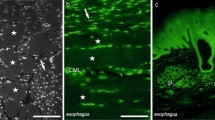Abstract
The internal anal sphincter is morphologically derived from the circular muscle of the rectum, but marked differences have been observed in the motor activities of these two morphologically continuous structures. Immunocytochemical studies using anti-neurotransmitter antibodies (vasoactive intestinal peptide, substance P, metenkephalin, neuropeptide Y), enzyme histochemistry for acetylcholinesterase, and electron microscopy were carried out on internal sphincter specimens from 14 patients with internal sphincter achalasia, 5 normal controls, and on rectum from 4 patients with Hirschsprung's disease (HD). The various peptide-containing nerves were increased in internal sphincter achalasia compared to normal controls and patients with HD. The pathophysiology of internal sphincter achalasia appears to differ from that of HD. It is a distinct clinical entity and should be considered separate from the latter.
Similar content being viewed by others
References
Alumets J, Fahrenkrung J, Hakanson R (1979) A rich VIP nerve supply is characteristic of sphincter. Nature 280: 155–156
Bishop AE, Polak JM, Lake BD (1981) Abnormality of the colonic regulatory peptides in Hirschsprung's disease. Histopathology 5: 676–688
Blook SR, Polak JM (1978) Peptidergic versus purinergic. Lancet I: 93
Buckell A, Whitney B (1964) A preliminary investigation of the human isolated taenia coli preparation. Br J Pharmacol 23: 164–175
Burnstock G (1972) Purinergic nerves. Pharmacol Rev 24: 509–557
Friedmann CA (1968) The action of nicotine and catecholamines on the human internal anal sphincter. Am J Dig Dis 13: 428–431
Furness JB, Costa M (1974) The adrenergic innervation of gastrointestinal tract. Rev Physiol Biochem Pharmacol 69: 1–40
Garret JR, Howard ER, Jones W (1974) The internal anal sphincter in the cat; a study of nervous mechanisms affecting tone and reflex activity. J Physiol (Lond) 243: 153–166
Hsu SM, Raine L, Fanger H (1981) Use of avidin-biotin-peroxidase complement (ABC) in immunoperoxidase techniques. J Histochem Cytochem 29: 577–580
Jessen KR, Polak JM, Van Hooden S (1980) Peptide containing neurones connect the two ganglionate plexuses of the enteric nervous system. Nature 5745: 391–393
Karnovsky MF (1965) A formaldehyde-glutaraldehyde fixative of high osmolarity for use of electron microscopy. J Cell Biol 27: 137–138A
Lake BD, Puri P, Nixon HH, Claireaux AE (1978) Hirschsprung's disease — an appraisal of histochemically demonstrated acetylcholinesterase activity in suction rectal biopsy specimen as an aid to diagnosis. Arch Pathol Lab Med 102: 244–247
Leander S, Hakanson R, Sundler F (1981) Nerves containing substance P, Vasoactive intestinal polypeptide, enkephalin or somatostatin in the guinea-pig taenia coli; distribution, ultrastructure and possible function. Cell Tissue Res 215: 21–39
Malmfors G, Leader S, Brodin E, Hakomson R, Holwein T, Sundler F (1981) Peptide containing neurons intrinsic to the gut wall, an experimental study in the pig. Cell Tissue Res 214: 225–238
Parks AG, Fishlock DJ (1967) Catecholamines. Proc R Soc Med 60: 217
Parks AG, Fishlock DJ, Cameron JDH (1969) Preliminary investigation of the pharmacology of the human internal sphincter. Gut 10: 674–677
Polak JM, Path MRC, Bloom SR (1979) Neuropeptides of the gut: a newly discovered major control system. World J Surg 3: 393–406
Neilson IR, Yazbeck S (1990) Ultrashort Hirschsprung's disease: myth or reality. J Pediatr Surg 25: 1135–1138
Said SI (1974) In: Endocrinology 1973, Proceedings 4th International Symposium, London, Heinemann, London Small J (ed), pp 297–301
Schaltzberg M, Dreyfus CF, Gerson MD (1978) VIP, enkephalin, substance P and somatostatin-like immunoreactivity evidence from organotype tissue cultures. Brain Res 155: 239–248
Sundler F, Hakanson R, Ekblad E (1986) Neuropeptide Y in the peripheral adrenergic and enteric nervous systems. Int Rev Cytol 102: 243–269
Taguchi T, Tanaka K, Ikeda K (1983) Peptidergic innervation irregularities in Hirschsprung's disease. Virchows Arch A 401: 223–225
Tsuto T, Okamura H, Fukui K (1982) An immunohistochemical investigation of vasoactive intestinal polypeptide in the colon of patients with Hirschsprung's disease. Neurosci Lett 34: 57–67
Author information
Authors and Affiliations
Additional information
Offprint requests to: T. Fujimoto
Rights and permissions
About this article
Cite this article
Fujimoto, T., Puri, P. & Miyano, T. Abnormal peptidergic innervation in internal sphincter achalasia. Pediatr Surg Int 7, 12–17 (1992). https://doi.org/10.1007/BF00180995
Issue Date:
DOI: https://doi.org/10.1007/BF00180995




